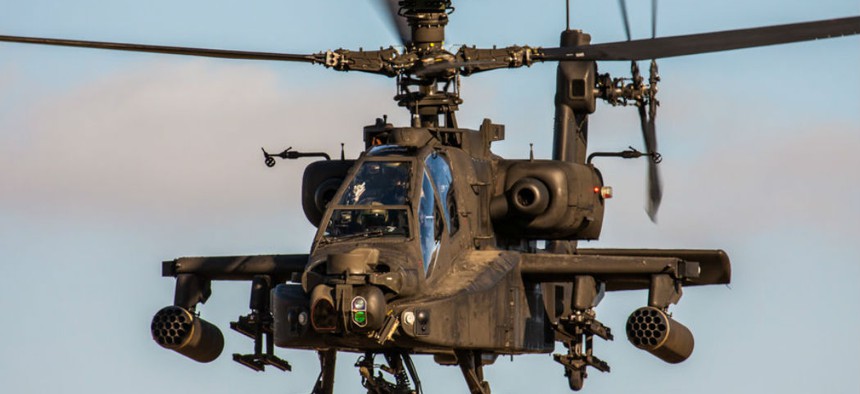Hughes offers 360-degree helicopter combat connectivity
A new SATCOM terminal for helicopters is designed to enable rotary aircraft to communicate the beyond-line-of sight communications.
Hughes Defense is working with the Navy to develop a 360-degree beyond-line-of-sight SATCOM terminal for helicopters that is designed to allow rotary aircraft to communicate without maneuvering into a specific position.
“With single terminal solutions, they lose line-of-sight with the satellite because there is no practical place a single satellite terminal can be mounted on a helicopter that won’t have some degree of signal blockage from the fuselage or rotor base,” said Rick Lober, Vice President and General Manager of the Defense and Intelligence Systems Division at Hughes Network Systems.
The technology, called HeloSat, operates below the rotor blades and uses an IP-based system for connectivity; GPS, however, is used for timing and antenna-pointing, Lober added.
Lober said the HeloSat system draws upon a new advancement in SATCOM technology that integrates a Hughes HM200 airborne modem and two lightweight antennas that are mounted on top of the helicopter's weapons platforms.
With a range greater than 150 miles, HeloSat is designed to perform command-and-control or ISR missions without terrain limits, such as mountains that block signals.
“The pilot will no longer have to account for direction and positioning of the aircraft to maintain in-flight connectivity,” he said.
HeloSat is 50 percent lighter than previous systems and is designed to be power-efficient. It is built with a roll-on/roll-off installation ability.
Future upgrades to HeloSat are planned for use with commercial satellite’s Ku band in addition to Ka band, Lober said.
Lober maintained that HeloSat could assist with currently deployed Army technology that allow helicopter crews to view video feeds from nearby drones. This technology, called Level of Interoperability 3 (LOI 3), allows Apache and Kiowa helicopter pilots to both view video feeds and control the sensor payload of drones.
The Army LOI 3 system uses an established line-of-sight networking technology called Tactical Common Data Link. This “manned-unmanned” teaming was recently used in combat in Afghanistan and warzone commanders have praised its impact as it allows helicopter crews to identify targets before taking off.
“HeloSat's capability gives beyond-line-of-sight connectivity to the ground. That would allow a paired helicopter and UAV to send their data back to the ground over satellites anywhere in the world where a mission requires it,” Lober said.
The HeloSat technology was recently demonstrated by Hughes when a NorthStar Aviation 407 Multi-Role Attack Helicopter was able to transmit HD video through its rotor blades.
It is also possible that HeloSat could be integrated into the Army’s Future Vertical Lift next-generation helicopter program. The effort, now going through demonstrations in a science and technology phase, aims to field a faster, more lethal high-tech helicopter platform by the 2030s. Demonstrator aircraft are now being built for initial flights coming up later this year. Part of the requirements for this new helicopter include the exploration of technologies and mission systems which are best able to position the platform for a 2030-and-beyond threat environment.
Although HeloSat is not yet a program of record with any U.S. military services, various entities – such as the Navy Air Systems Command -- are working with Hughes and examining the prospect of integrating the technology onto helicopter platforms.
NEXT STORY: Mosul battle fuels anti-drone development





